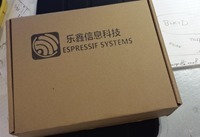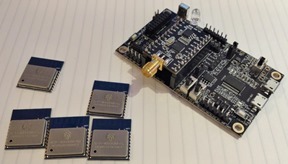 Let me start by explaining that Espressif are makers of fine WIFI gadgets.. specifically they have spawned a whole new lease of life for IOT… by producing a marvellous little chip that contains a complete processor, memory and WIFI interface needing only a tiny FLASH memory chip and a couple of “bits and bobs” to make a complete working WIFI router, or IOT device or web server – largely limited to the imagination for, well, a couple of pounds ££… the price is really what does it – you can buy a little board complete with aerial for less than £2 from China which is just a complete game changer.
Let me start by explaining that Espressif are makers of fine WIFI gadgets.. specifically they have spawned a whole new lease of life for IOT… by producing a marvellous little chip that contains a complete processor, memory and WIFI interface needing only a tiny FLASH memory chip and a couple of “bits and bobs” to make a complete working WIFI router, or IOT device or web server – largely limited to the imagination for, well, a couple of pounds ££… the price is really what does it – you can buy a little board complete with aerial for less than £2 from China which is just a complete game changer.
 And for everyone else, well, you know I’ve been working with these chips since day one and am just about to start fitting controllers all over the house etc. based on an overall setup that has been years in the formulation (in English lots of false starts) and currently comprises NETIO for the user control end (possibly soon to be replaced by ThingStudio if all goes well with their current alpha software), Node-Red and Mosquito on a Raspberry Pi2, controlling lots and lots of ESP8266-based boards around the place.
And for everyone else, well, you know I’ve been working with these chips since day one and am just about to start fitting controllers all over the house etc. based on an overall setup that has been years in the formulation (in English lots of false starts) and currently comprises NETIO for the user control end (possibly soon to be replaced by ThingStudio if all goes well with their current alpha software), Node-Red and Mosquito on a Raspberry Pi2, controlling lots and lots of ESP8266-based boards around the place.
And so… with that in mind I’ve been in contact a number of times with Espressif and they’ve been helpful and keep me up to date. So the other day I received an email to say they were sending me some stuff to play with! This morning, an envelope arrived in the post.
 Inside a large cardboard box – inside that, a package and inside that – a development board and some little modules.
Inside a large cardboard box – inside that, a package and inside that – a development board and some little modules.
The modules look like ESP-12s but have 2 less connectors – which means no A/D output !! They do have an internal aerial and are marked ESP-Vroom-02 and are “developer only. The pin-out is not compatible with the ESP-12 which is slightly painful as that means a new rig to program them! At some point it will be clear to me why they made these, leaving out the A/D – but for now it’s a mystery.
More interesting perhaps is the development board. It is rather tempting to compare it to another development board that appeared on Ebay a short while ago.
THe Espressif development board is much smaller and neater but contains a unit that has no less than 24 pins coming out – the most I’ve EVER seen. It does not unfortunately have an internal aerial so I’ll have to go and hunt out a suitable screw-in job. The board is marked ESP8266EX Demo Board and has more connectors than you can shake a stick to. It has an infra-red input, but micro-USB uart and general micro-USB inputs, 5 switches…
and that’s about it – just got this in the post, thought you might like to see the stuff – not done any experimenting yet, no doubt that will follow soon.


Hmm, my last post seems to have disappear into the ether. I'll make this shorter then.
Basically, the reason I'd use an Arduino is that I'm familiar with it. I know how to make stuff with one and there are lots of support libraries and examples – such as putting it into sleep mode. I can't say the same for the ESP. Is it as easy to use? Could I easily dump one onto a breadboard and program it with a simple subset of C? I'm not a C programmer, indeed I'm not a programmer at all these days. Enterprise IT is my thing. I can make my own Arduino on a breadboard thanks to Cefn Hoile (ShrimpingIT) and even transfer it to some stripboard but that's about the extent of my electronic skills right now.
It looks to me as though it would be easy to take one of the ESP8266 serial boards and use it with an Arduino?
From what I can tell, it has a rapid startup, <2ms is being quoted but I think that is to first packet. I'm not sure how many packets it would take to reconnect to a network, do you know? Or how long the device needs to be powered up before it will actually communicate over the network?
If it isn't too bad, I should be able to cut the power to the ESP8266 and send the Arduino to sleep. I only need a sensor reading every 5 minutes for most sensors. There are a few examples of putting the Arduino to really low power states: here and here for example. But if it takes 30-50 seconds of high power use to wake the ESP8266 up, connect to the network and send some data, I'm not sure whether that would kill the batteries too quickly. It also looks like people are saying that the ESP needs quite a lot of power, around 300mA to work reliably.
There is an article on using the ESP with Arduino here. It looks interesting enough that I might try one.
I'd be interested in your thoughts.
So to answer your first para – yes, it is easy to have an ESP8266 talk to an Arduino via serial – I’ve settled for simple JSON.
I’ve not really gone for speedtest – from power up I’ve been looking at a couple of seconds or so before it connects to a network but I’m sure one could do better.
I guess you have to ask the question.. and WHY do we need the Arduino?
Well, a very good question Peter as always!
I guess mainly because I'm familiar with it and not with the ESP itself. I know how to program it and it is pretty straight-forward. I got rather the impression regarding the ESP that this isn't the case with talk of development boards and C compilers. I'm not a C programmer and never will be. I can just about cope with simple things on the Arduino though without many of the libraries available, I'd be lost.
Turning the Arduino into sleep mode for example is well documented as is connecting hardware to it I'm not that good at electronics either! I'm an enterprise IT person – I can steer you through the intricacies of a multi-million pound IT infrastructure project and guide you through cyber security issues but I struggle to remember which way round to wire an LED!
So at the moment, I'm staring at an Arduino with a wireless card plugged in connected to a breadboard with a bunch of sensors on it – they all happen to be mounted on a wheeled robot because that's where they last ended up when I was messing around with my son. I also learned how to make my own Arduino clone thanks to someone in North Wales who has a kit he designed for schools. It works though and I know why and can reproduce it.
Very nice board indeed. I like that antenna can be connected directly on the module and IR port. One question, module how much FLASH memory has ?
Hi again Peter, I think I’m going to have to add your RSS feed to my regular read!
I’m interested in power management with these units.
One of the tasks I’ve set myself is to create some really low power sensors. Ones that will run a year or more off no more than a couple of AAA or AA batteries. Current thoughts have revolved around self-build 3.3v Arduino clones with Ciesco 433MHz SRF radios. These support both encryption (as you may have realised, I’m rather passionate about securing IoT) and ultra low power modes.
So I’d be interested in your take on using Wi-Fi modules instead. I’ve always assumed that the networking overheads with Wi-Fi would mean much higher power consumption requirements.
Regards, Julian.
The WIFI modules do indeed use more power Julian and I’ve not really investigated the SLEEP option – apparently in the latest SDK doc there is something about sleep and I do know you can use this if you tie GPIO16 to reset… how much power you save with what duty cycle I’m not sure, but these Expressif chips are so powerful it surely has to be worth some R&D. I can’t tell you how much time I wasted on various radio solutions before stumbling onto this stuff.
Thanks Peter, I was afraid of that. There are so many overheads with setting up a Wi-Fi connection I think it inevitable. That’s why I’m interested in the Ciesco modules. Fairly cheap at around £10, Driven with simple serial AT commands, low power & available ready packaged both for Pi & Arduino, decent signal distance and speed. They also have a tine Arduino clone with a radio built in.
At least we now have lots of low-cost options from the 433MHz & 1.2GHz modules, bluetooth and Wi-Fi all at decent prices.
Julian
I have been using the Ciseco products for a couple of years and they are excellent. The low power modes work really well and I can power them from 3v lithium coin cells (see their sensor range that includes a box). I dont think that I will get close to the battery consumption levels on the ESP8266 as yet.
So now I have a mixture of products in the house but they all get consolidated through Node Red onto the MQTT bus, so it doesnt matter really!